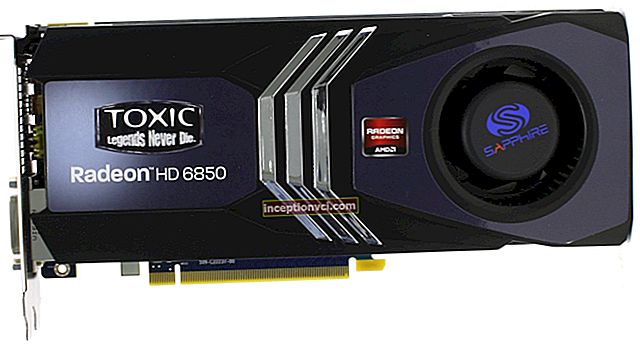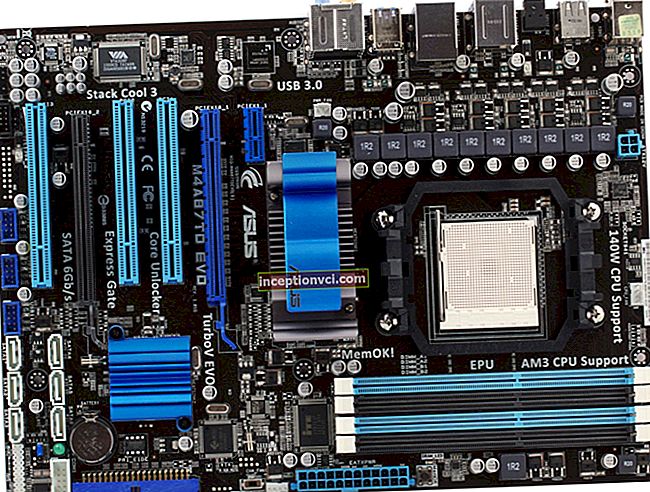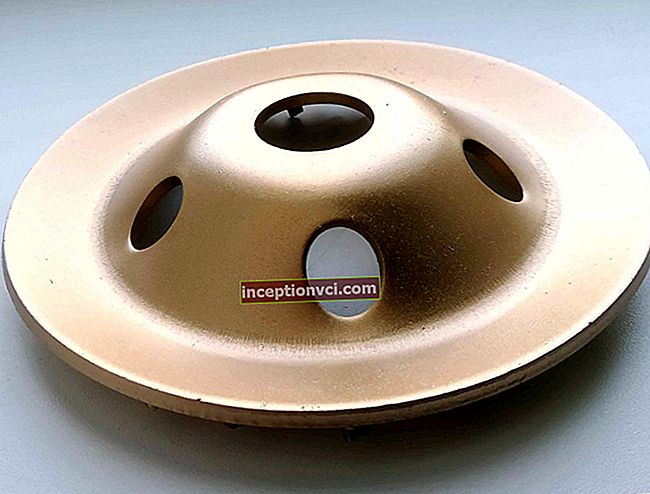Recently, it is already somewhat unusual to see products that do not have any "bells and whistles" in their arsenal, it has become so customary to see all kinds of light bulbs, switches for hardware overclocking and unlocking hidden processor cores, or at least a non-standard arrangement of SATA ports, which recently it is customary to place it in a horizontal plane. The motherboard we are considering today ASUS M4A87TD EVO to a greater extent focused on users for whom the main functionality of the motherboard is the main, and sometimes even the determining factor, when making a purchase decision. And this board really boasts a rather impressive set of functions and supported technologies, but first things first.
Overview of board features
The motherboard in question is based on the junior model of the latest eighth series of chipsets from AMD. Asus engineers took the AMD 870 north bridge as a basis, but the most modern south bridge - AMD SB850 - was paired with it. As a matter of fact, this tandem largely determines the set of functional capabilities of the product in question. First, you should decide on the question of what is the fundamental difference between the functional capabilities of the used system logic set from the current flagship AMD 890FX chipset.
In fact, when comparing officially supported technologies, it is clear that the existing functional differences are not so significant. So, compared to older models, there is no support for ATI CrossFireX technology and, unlike the flagship, there is a smaller number of PCI-E lines, of which 16 are allocated for the needs of the graphics subsystem. And besides, to reduce the cost of the final product, this chipset does not have an integrated graphics core, and as a result support for related technologies such as ATI Stream Technology and ATI Powerplay.
Now let's try to figure out how seriously the cut-backs in the chipset's functionality affected the final performance of the motherboard. It's no secret that much depends not so much on the capabilities of the system logic, but on the implementation of these functions in a specific solution. So, for example, in this board, even despite the official lack of support for the CrossFire technology by the AMD 870 chipset, there is a second connector for installing a video accelerator. Naturally, one should not expect a significant increase in the performance of the graphics subsystem from the use of two video cards, since only four lines from the number of backup lines of the north bridge are allocated for the needs of the second PCI-E port. Naturally, there is some logic in such a solution, since when a second video card is used in the system, the lines for the first port are not cut, and the main video accelerator continues to work in x16 mode. The ports are located at a double distance, which, of course, will allow you to install a video card into the first connector even with a very bulky cooling system, but the second connector does not have so much space at its disposal and the installation of a wide video card will partially block access to the SATA connectors on the motherboard. Although the speed formula of the second PCI-E x4 port deprives any common sense of buying a high-performance video card for the second port. Although the board is not intended for creating high-performance systems with two graphics adapters, the second card will be used to a greater extent as a physical accelerator.
The motherboard in question will undoubtedly be a very good choice for users planning an upgrade and who have a significant set of expansion cards in their old systems, since Asus engineers have implemented as many as three PCI ports on the board. Of course, when using a video adapter with an overall cooling system, the user will “lose” one of the PCI slots, and nevertheless there will be two more. In general, this motherboard can be attributed to the middle segment of motherboards available on the market, or more precisely, to the upper border of this segment.
There is also an eSATA interface on the board, but it is not implemented due to internal ports or chipset lines, but through an external additional controller, but it is very unpleasant that it only supports version 2.0, although it was quite possible to use a controller that has support for the third version, for example, the Marvell chip SE9123.
There is also a hardware switch on the surface of the motherboard for unlocking hidden cores. However, to a greater extent, it is not needed there, and its presence in it strongly resembles a marketing ploy, since activation of the unlocking mode of hidden cores and cache memory is possible at system startup, while the user does not even have to enter the BIOS menu. To activate the mode, just press the number four when the system starts up while the motherboard splash screen with the model name and tips on how to enter the BIOS is displayed on the screen, while at the very bottom there is an indication of the function status and it is indicated that the system is active or it is written that it is required to activate it press key 4, which is much more convenient than getting inside the system unit. Also on the surface of the board there is a MemOK button, the purpose of which is to select the operating modes of the RAM modules, if the system cannot start due to the difference in the timings of the installed memory strips. Those. theoretically, in the case of installing several memory modules, the characteristics of which are significantly different, when you press this button, an automatic selection of the parameters for the joint operation of the modules should occur. In practice, it turned out that such issues can be easily dealt with by setting the BIOS to automatically select the voltage supply of the RAM and the timings of the modules, after which we succeeded, safely will start the system, even with different memory modules.
The radiators of the north and south bridges, which have already become a kind of visiting card of motherboards from Asus, have not only a fancy decorative shape, but also quite decently cope with their direct responsibilities for cooling. However, in the case of using a low-speed processor cooler or installing a water cooling system for cooling the processor, the heating level can increase to 45-50 degrees, which in principle is permissible, but undesirable, so this fact must be taken into account and still try to create at least minimal air movement in the area of the radiators.
The implementation of the mainboard voltage regulator deserves special attention and all praise. As for a mid-level motherboard, its implementation can be said that it is even excessively good, although there can be no concept of excessiveness in this matter. The stabilizer is made of nine channels. One of the nine channels is designed exclusively for powering the north bridge, which is integrated into the processor, which in itself is quite a good start for the near future. Installed two dozen field-effect transistors, and half of them are highly efficient branded field-effect transistors that support the Low RDS (on) function. The manufacturer declared support for installation by a processor with a thermal package of no more than 140 watts, which will allow the use of most processors currently on the market, including even modern six-core processors, such as a good processor cooler can be quite successfully overclocked, especially since there is everything for this necessary technologies.
The package contains a user manual and installation instructions, a disk with a standard set of proprietary utilities for overclocking and monitoring the system and drivers, an Asus proprietary sticker on the case, a pair of Q-connectors to facilitate the user of the process of connecting the front panel to the motherboard, an IDE cable and four SATA cables with metal latches to securely fix the cable in the connector, and two of them are intended for connecting devices using the high-speed SATA v3.0 interface.
Overview of the functionality of the motherboard ASUS M4A87TD EVO
As noted above, the motherboard in question is built on the basis of a set of system logic consisting of the AMD 870 North Bridge and SB850 South Bridge. As a matter of fact, this is the main factor that provides support for processors exclusively with Socket AM3, and allows you to use DDR3 modules with a frequency of 1066 MHz to 1600 MHz as RAM, with a total volume of no more than 16 gigabytes, installing them into the existing four slot. The disk system can be based on six SATA v.3.0 connectors, while it is possible to create RAID arrays of the following configurations: RAID 0, 1, 0 + 1 and 5. In addition, there is an IDE connector that allows you to connect two PATA / 133. However, the availability of support for this type of device has recently begun to be perceived more and more not as a necessity, but as a bonus application, and quite often completely useless for the user, although in the case of disk drives of this standard that the user has left after the upgrade, the presence this interface connector will come in handy.
In addition to the standard set of functionality provided by the chipset, there are also additional functions implemented through external additional controllers. Thus, eight-channel HD sound is realized using the VIA VT1818 controller. The Realtek RTL8111E network controller has made it possible to support the Gigabit Ethernet technology. There are two USB v.3.0 ports, which are based on the NEC D720200F1 controller, which uses one PCI-E line for its needs. The motherboard has two FireWire ports corresponding to the IEEE 1394a standard, implemented by means of the VIA VT6308P controller, and one of the ports is located on the rear panel, while the second is internal and can be freely used for output to the front panel in cases with an IEE1394 port on the front panel. Traditionally, to test the performance of motherboards, we also tested the signal quality through the analog audio outputs. For testing, we used the RightMark Audio Analyzer 6.2.3 program.
The table above shows the general results of testing the audio signal quality. The overall test score is “Good”. Naturally, such unconvincing results of audio signal testing for such a successful audio codec as VIA look somewhat strange. There are no even suggestions about the possible reasons for such results. It is quite possible that this is due to the peculiarities of the hardware implementation of the analog output or software, and specifically the BIOS version. Moreover, in the vastness of the Internet, in numerous forums, there are complaints about the sound quality, the appearance of sound jitter and extraneous noise, but all of them managed to get a positive result after updating the BIOS version, which gives hope for a software flaw.
A few words should be given to the layout of the elements on the board surface. An external examination of the board itself, as well as the elements, showed a fairly high level of assembly and soldering of the motherboard elements. All capacitors used on the board are solid-state, which gives additional confidence in a longer and more reliable life. The connectors for connecting peripheral devices are located quite ergonomically, they are shifted to the edge of the board, which will allow you to neatly lay the cables when assembling the system, which will not impede air circulation. However, the first "teaspoon" is hidden in this very. Since the board is slightly narrower than most ATX boards, the edge of the board sags in the air. Therefore, the connection of the connectors should be done with extreme caution.
Moreover, in addition to being careful when connecting connectors, be careful when installing memory modules, especially when installing modules in extreme connectors, since there is a high risk of damaging the board. Actually, it is much safer to install memory modules even before installing the motherboard in the case.
Performance testing
An absolutely indisputable fact is that, first of all, a potential buyer is interested in the performance of the motherboard. Therefore, let's try to evaluate the performance of the board. The test system, in addition to the motherboard itself, also contained the following components:
CPU - AMD Phenom II X3 720 2800Mhz;
Cooler - Zalman CNPS9900A
RAM - Geil DDR3 2x4096Mb PC3-12800 1600MHz (GVP38GB1600C9DC)
Video adapter - MSI Radeon HD6950 2048Mb GDDR5 800Mhz
Winchester - Seagate 2000GB 64MB 5900rpm 3.5 "SATAIII (ST2000DL003)
Optical Drive -Asus DRW-24B3ST DVD-RW DL SATA
Power supply unit -Thermaltake TR2 RX 1000W (TRX-1000M)
Housing -Chieftec BA-01B-B-B
Naturally, it is possible to fully evaluate the performance of the product only when comparing with other models of a similar level. For comparison, we have selected the following models of motherboards based on the AMD 8xx series chipset:
Gigabyte GA-890GPA-UD3H
Asus M4A88TD-V EVO / USB3
MSI 890FXA-GD70 AM3 ATX
The performance test results, carried out using various synthetic tests, show that the performance of the motherboard in question, even though it is based on the youngest chipset of the line, is practically not inferior in performance to solutions with older chipsets.
ASUS M4A87TD EVO motherboard BIOS review
As a basis for the BIOS, Asus engineers took the code from the AMI company, which is found in most products on the market, and therefore it is similar to the menu in other products based on the same code. The differences are only in the set of functionality and control limits and control step. When entering the BIOS menu, the user enters the AI Tweaker menu, which is designed to manage the overclocking parameters of the system. In more detail, the possibilities and available settings of this menu will be discussed below, in the section devoted to overclocking.
The next menu, Advanced, allows you to access control of the parameters of the processor and its cores. Allows you to view current information about processor parameters and manage technologies such as Cool'n'Quiet and Asus core unlocker.
The Power tab gives the user access to monitoring information about the state of the system as a whole. Everything here is completely normal, there is information about temperatures, voltages and fan speeds at critical points in the system.
The Tools tab allows you to access proprietary technologies from Asus and also provides the ability to save and manage your system's overclocking profiles.
Review of overclocking capabilities of the motherboard ASUS M4A87TD EVO
The table shows the ranges for adjusting characteristics in the BIOS menu, which are available to the user for overclocking. The available settings are quite conveniently grouped and have the function of previewing the resulting frequency value, which is displayed next to the variable parameter of the multiplier or reference frequency. But when choosing the parameters of the supply voltage, the user can also see the current voltage value and standard base values.It is possible to set either the absolute value of the value, or its value depending on the value of another parameter, or set the automatic change of the system parameters by activating the Cool'n'Quiet technology.
The AMD Phenom II X3 720 2800Mhz processor we used in our tests managed to unlock the hidden fourth core without any problems, which in itself is a rather pleasant moment. However, we continued to determine the overclocking potential with the unlocked fourth core, since this operating mode of the processor and the system as a whole will be the most interesting for a potential buyer.
The processor with an unlocked core as a result of overclocking quite calmly allowed to achieve a result of 330 MHz on the system bus, which is a fairly good result, especially if we take into account the fact that the overclocking was performed on a motherboard with the youngest chipset model from the AMD8xx line. The overclocking potential of the board was tested in the same way using the proprietary ASUS TurboV EVO utility.
Using the simplest overclocking method for overclocking, which is to increase the processor multiplier, we managed to achieve an impressive 3.1 GHz result.
Overclocking by increasing the value of the reference frequency brought even greater results. We managed to achieve stable operation of the system at 3.41 GHz.
But as it turned out, this result was not the maximum limit for this motherboard. Using the proprietary ASUS OC Tuner utility during overclocking, we managed to get an impressive 3.51 GHz.
conclusions
Summing up all of the above with regard to the ASUS M4A87TD / USB3 motherboard, we can say with confidence that the board turned out to be very successful. It is clearly oriented towards a wide range of tasks, and is intended for a wide range of users. The manufacturer clearly tried to satisfy the needs of the widest possible range of consumers. Here we also see quality assembly using advanced technology and components such as solid capacitors. Naturally, for a product of this level, it would be foolish to expect over performance. Actually, no one demanded this. So users who primarily want to build a high-performance gaming system with two installed video adapters, this product is definitely not intended. The second PCI-E slot is more suitable for users who have components left over from the previous system after the upgrade, and they will be able to use the "old" video card as a physical accelerator. Naturally, like any of the best products, this board has its positive and negative sides. So, the undoubted advantages of this motherboard include the presence of new, ultra-high-speed data transfer interfaces SATA and USB of the third version. It is also worth noting good overclocking potential, which, to be honest, no one expected from a mid-range motherboard, complete with the ability to unlock hidden cores. Also an undoubted advantage is a high-quality processor voltage regulator system, which is made on a par with top-class products. Well, the most important trump card is the cost of the product in the region of $ 100.









